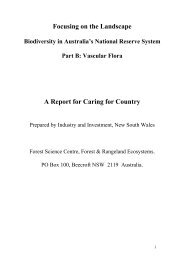Biodiversity in Australia's National Reserve System - Part ... - BushBlitz
Biodiversity in Australia's National Reserve System - Part ... - BushBlitz
Biodiversity in Australia's National Reserve System - Part ... - BushBlitz
Create successful ePaper yourself
Turn your PDF publications into a flip-book with our unique Google optimized e-Paper software.
afforded to species for which we have few site records. Species that are likely to be under<br />
represented <strong>in</strong> PAs can be considered for priority conservation action if land clearance and/or<br />
degradation is/are likely to be an immediate and severe threaten<strong>in</strong>g process.<br />
Methods<br />
The methods used <strong>in</strong> this paper are based on those used to undertake a similar analysis of<br />
frogs by Lemckert et al (2009).<br />
The 2006 CAPAD database lists 8780 IUCN criteria PAs (see Figure 1) that protect<br />
768,826,956 hectares (11.6%) of cont<strong>in</strong>ental Australia, <strong>in</strong>clud<strong>in</strong>g Tasmania (see Table 3).<br />
This level of reservation provided the basel<strong>in</strong>e for comparisons of the expected reservation<br />
levels for each group.<br />
Records for each group were supplied by the Australian Government Department of the<br />
Environment, Water, Heritage and the Arts through the Australian Natural Heritage<br />
Assessment Tool (ANHAT) database. This database has been compiled from specimen and<br />
site records held <strong>in</strong> State, Territory and Commonwealth flora and fauna collections and<br />
wildlife atlases, and from the work of <strong>in</strong>dividual researchers. ANHAT is a custom-designed<br />
analysis tool built on Microsoft Access (Microsoft, 2003) and ArcGIS geographic<br />
<strong>in</strong>formation system (ESRI, 2005).<br />
Data was supplied on the follow<strong>in</strong>g terrestrial groups: mammals, birds, reptiles, frogs, trapdoor<br />
spiders, huntsman spiders, butterflies, land snails, carabidae land beetles, dytiscidae<br />
water beetles and the dragonflies and damselflies. This <strong>in</strong>cluded data on species that have yet<br />
to be formally described.<br />
Records dated pre-1950 were excluded from the data sets, as earlier historical site records<br />
rarely have sufficient spatial accuracy for this type of analysis. Furthermore, site records<br />
with a spatial error range >20 km were excluded and duplicate records removed. Records<br />
with<strong>in</strong> 500 m of each other were considered the same site and listed as a s<strong>in</strong>gle spatial record.<br />
Due to time limitations, review of taxonomic and nomenclatural changes of the species <strong>in</strong><br />
ANHAT was not performed. Time limitations also meant that names of undescribed species<br />
were not able to be put <strong>in</strong>to the correct taxonomic format, so that <strong>in</strong> many cases <strong>in</strong>formal<br />
names may appear italicised and/or not <strong>in</strong>dicative of taxonomic rank.<br />
With<strong>in</strong> each of the n<strong>in</strong>e groups, any species with fewer than 30 records for vertebrates and<br />
fewer than 10 records for the <strong>in</strong>vertebrates was noted and removed from further<br />
consideration. Such species may have been rarely recorded because they are rare, because<br />
they occur <strong>in</strong> remote locations, because they are very cryptic or through a comb<strong>in</strong>ation of<br />
these factors. Regardless, we removed them because we believe it is difficult to assess the<br />
relative state of reservation of such species with reasonable accuracy. For example, if a<br />
species has two site records and both fall <strong>in</strong> a reserve, it is not reasonable to assume that it is<br />
highly protected when most of its predicted range falls outside of reserves. We also removed<br />
species that are now considered ext<strong>in</strong>ct, have suffered recent serious decl<strong>in</strong>es or have been<br />
named relatively recently. Records for recently decl<strong>in</strong>ed species may not provide an accurate<br />
assessment because many are from sites where the species is not longer extant. The recovery<br />
of these species is unpredictable and so assess<strong>in</strong>g their relative reservation levels <strong>in</strong>to the<br />
future is difficult.<br />
9






